Analysis of Customer-Centric Marketing: Unilever's Approach
VerifiedAdded on 2021/07/20
|22
|5922
|221
Report
AI Summary
This report analyzes Unilever's customer-centric marketing strategy, focusing on its approach to achieving a competitive advantage. The study employs a mixed-methods research design, including a deductive approach, descriptive research design, and both qualitative and quantitative data collection methods. Primary data was gathered through surveys and interviews with Unilever employees and managers in the United Kingdom. The research explores the benefits of customer-centric marketing, such as improved customer understanding and product development, while also identifying challenges related to competitive decision-making and economic factors. The findings, presented through data analysis and discussion, highlight the importance of prioritizing customer needs and behaviors to enhance business performance. The report concludes with recommendations for strategic improvements and includes a reflective analysis of the researcher's perspective, covering research onion, research philosophy, approach, design, strategy, sampling technique, ethical considerations, and limitations.
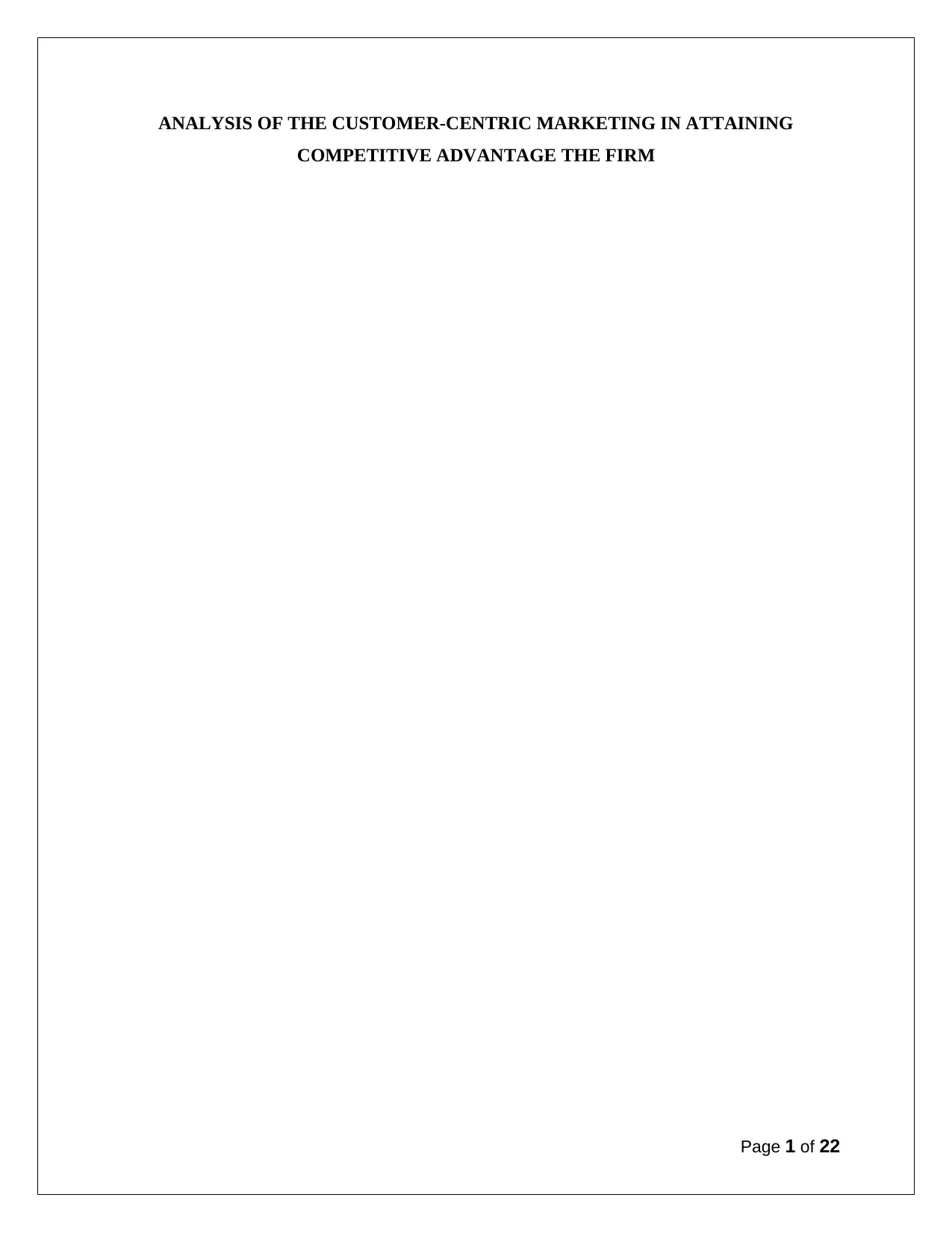
ANALYSIS OF THE CUSTOMER-CENTRIC MARKETING IN ATTAINING
COMPETITIVE ADVANTAGE THE FIRM
Page 1 of 22
COMPETITIVE ADVANTAGE THE FIRM
Page 1 of 22
Paraphrase This Document
Need a fresh take? Get an instant paraphrase of this document with our AI Paraphraser
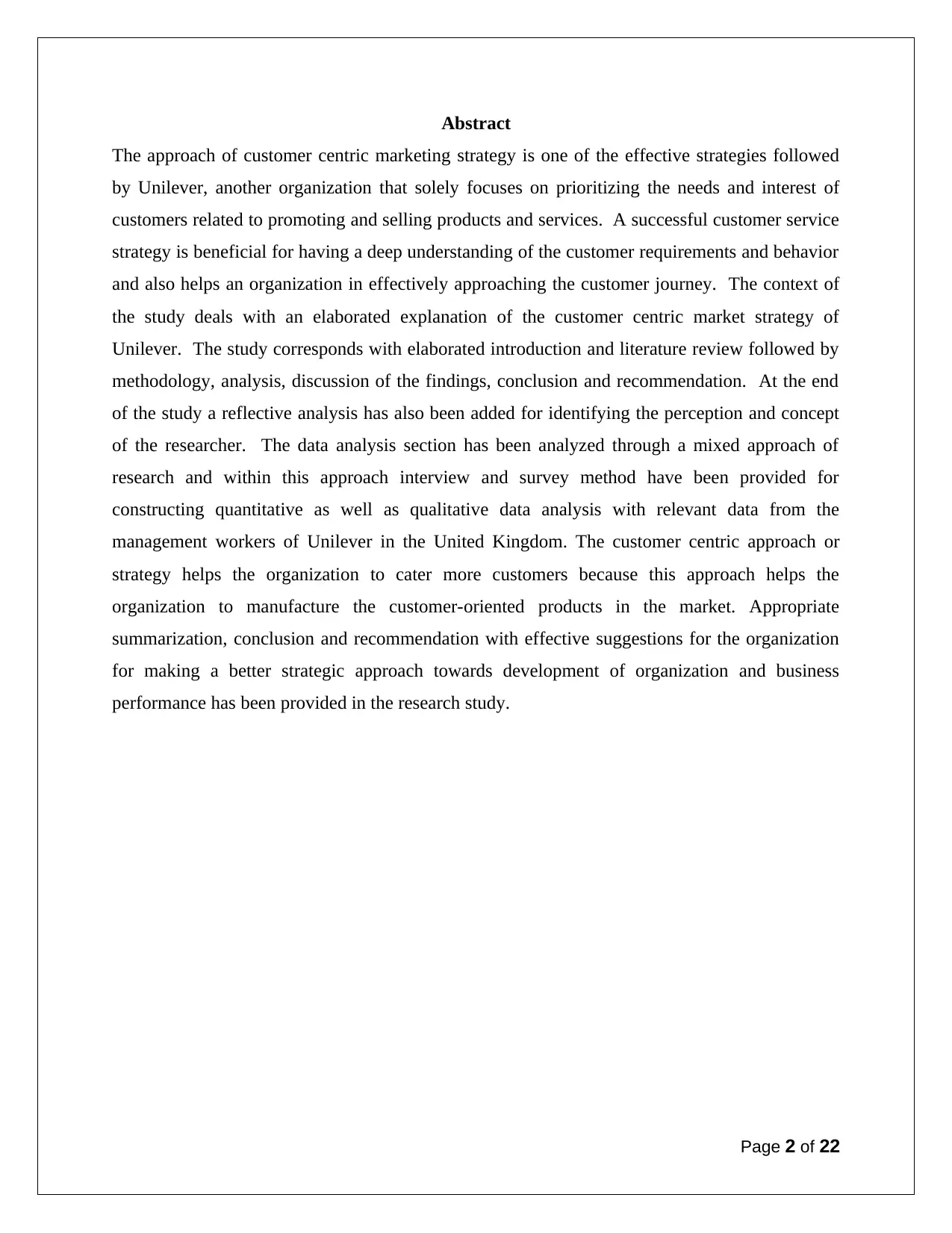
Abstract
The approach of customer centric marketing strategy is one of the effective strategies followed
by Unilever, another organization that solely focuses on prioritizing the needs and interest of
customers related to promoting and selling products and services. A successful customer service
strategy is beneficial for having a deep understanding of the customer requirements and behavior
and also helps an organization in effectively approaching the customer journey. The context of
the study deals with an elaborated explanation of the customer centric market strategy of
Unilever. The study corresponds with elaborated introduction and literature review followed by
methodology, analysis, discussion of the findings, conclusion and recommendation. At the end
of the study a reflective analysis has also been added for identifying the perception and concept
of the researcher. The data analysis section has been analyzed through a mixed approach of
research and within this approach interview and survey method have been provided for
constructing quantitative as well as qualitative data analysis with relevant data from the
management workers of Unilever in the United Kingdom. The customer centric approach or
strategy helps the organization to cater more customers because this approach helps the
organization to manufacture the customer-oriented products in the market. Appropriate
summarization, conclusion and recommendation with effective suggestions for the organization
for making a better strategic approach towards development of organization and business
performance has been provided in the research study.
Page 2 of 22
The approach of customer centric marketing strategy is one of the effective strategies followed
by Unilever, another organization that solely focuses on prioritizing the needs and interest of
customers related to promoting and selling products and services. A successful customer service
strategy is beneficial for having a deep understanding of the customer requirements and behavior
and also helps an organization in effectively approaching the customer journey. The context of
the study deals with an elaborated explanation of the customer centric market strategy of
Unilever. The study corresponds with elaborated introduction and literature review followed by
methodology, analysis, discussion of the findings, conclusion and recommendation. At the end
of the study a reflective analysis has also been added for identifying the perception and concept
of the researcher. The data analysis section has been analyzed through a mixed approach of
research and within this approach interview and survey method have been provided for
constructing quantitative as well as qualitative data analysis with relevant data from the
management workers of Unilever in the United Kingdom. The customer centric approach or
strategy helps the organization to cater more customers because this approach helps the
organization to manufacture the customer-oriented products in the market. Appropriate
summarization, conclusion and recommendation with effective suggestions for the organization
for making a better strategic approach towards development of organization and business
performance has been provided in the research study.
Page 2 of 22
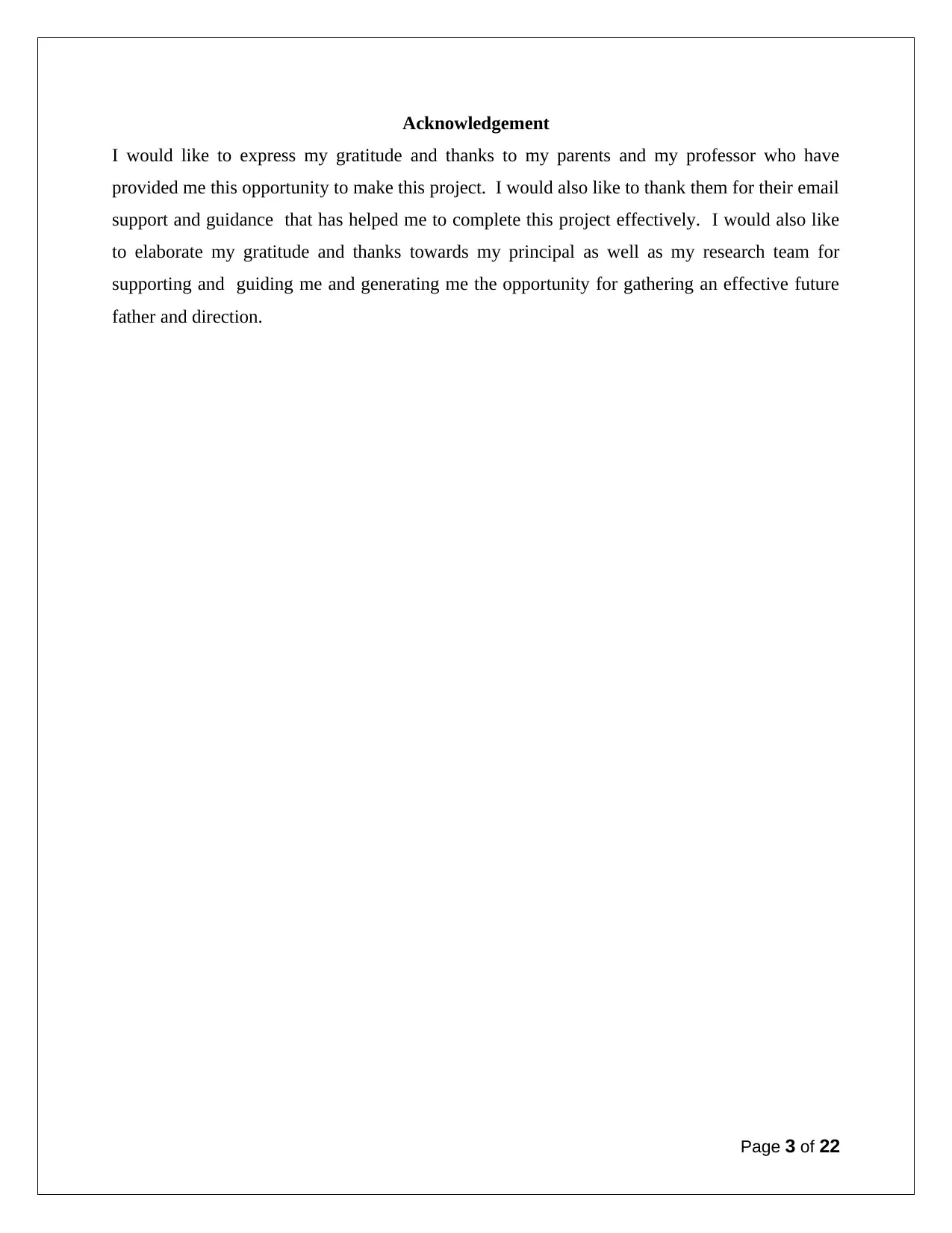
Acknowledgement
I would like to express my gratitude and thanks to my parents and my professor who have
provided me this opportunity to make this project. I would also like to thank them for their email
support and guidance that has helped me to complete this project effectively. I would also like
to elaborate my gratitude and thanks towards my principal as well as my research team for
supporting and guiding me and generating me the opportunity for gathering an effective future
father and direction.
Page 3 of 22
I would like to express my gratitude and thanks to my parents and my professor who have
provided me this opportunity to make this project. I would also like to thank them for their email
support and guidance that has helped me to complete this project effectively. I would also like
to elaborate my gratitude and thanks towards my principal as well as my research team for
supporting and guiding me and generating me the opportunity for gathering an effective future
father and direction.
Page 3 of 22
⊘ This is a preview!⊘
Do you want full access?
Subscribe today to unlock all pages.

Trusted by 1+ million students worldwide
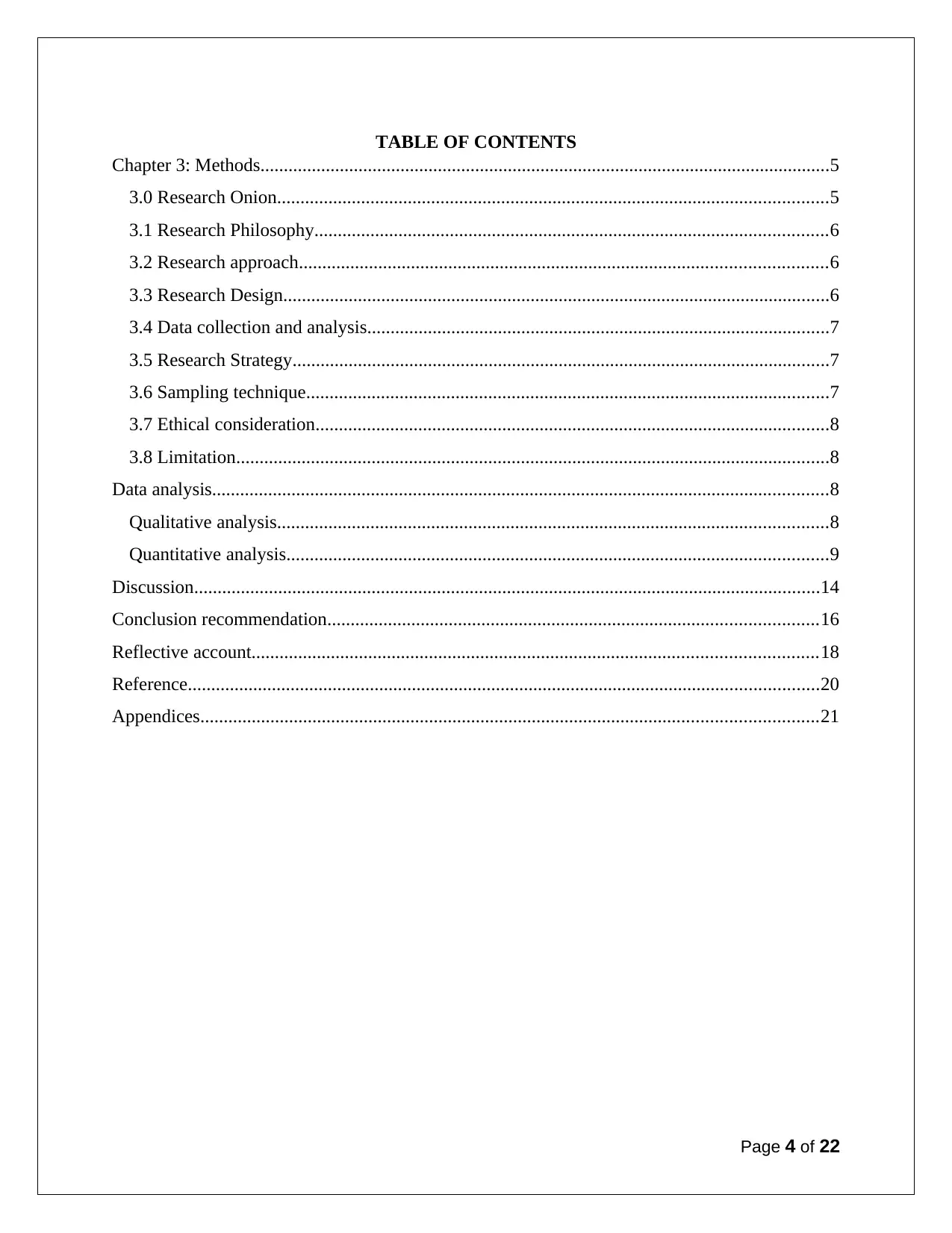
TABLE OF CONTENTS
Chapter 3: Methods..........................................................................................................................5
3.0 Research Onion......................................................................................................................5
3.1 Research Philosophy..............................................................................................................6
3.2 Research approach.................................................................................................................6
3.3 Research Design.....................................................................................................................6
3.4 Data collection and analysis...................................................................................................7
3.5 Research Strategy...................................................................................................................7
3.6 Sampling technique................................................................................................................7
3.7 Ethical consideration..............................................................................................................8
3.8 Limitation...............................................................................................................................8
Data analysis....................................................................................................................................8
Qualitative analysis......................................................................................................................8
Quantitative analysis....................................................................................................................9
Discussion......................................................................................................................................14
Conclusion recommendation.........................................................................................................16
Reflective account.........................................................................................................................18
Reference.......................................................................................................................................20
Appendices....................................................................................................................................21
Page 4 of 22
Chapter 3: Methods..........................................................................................................................5
3.0 Research Onion......................................................................................................................5
3.1 Research Philosophy..............................................................................................................6
3.2 Research approach.................................................................................................................6
3.3 Research Design.....................................................................................................................6
3.4 Data collection and analysis...................................................................................................7
3.5 Research Strategy...................................................................................................................7
3.6 Sampling technique................................................................................................................7
3.7 Ethical consideration..............................................................................................................8
3.8 Limitation...............................................................................................................................8
Data analysis....................................................................................................................................8
Qualitative analysis......................................................................................................................8
Quantitative analysis....................................................................................................................9
Discussion......................................................................................................................................14
Conclusion recommendation.........................................................................................................16
Reflective account.........................................................................................................................18
Reference.......................................................................................................................................20
Appendices....................................................................................................................................21
Page 4 of 22
Paraphrase This Document
Need a fresh take? Get an instant paraphrase of this document with our AI Paraphraser
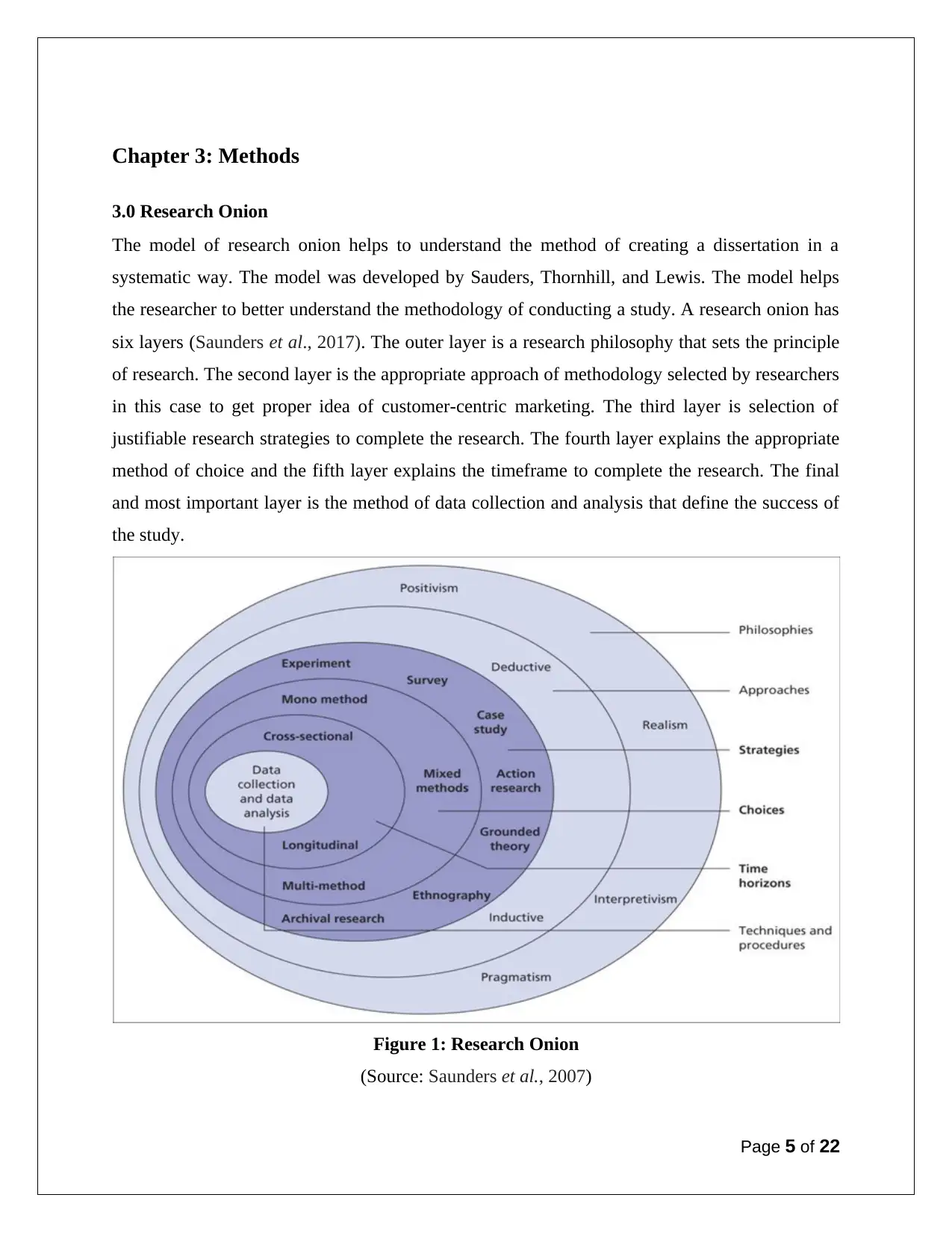
Chapter 3: Methods
3.0 Research Onion
The model of research onion helps to understand the method of creating a dissertation in a
systematic way. The model was developed by Sauders, Thornhill, and Lewis. The model helps
the researcher to better understand the methodology of conducting a study. A research onion has
six layers (Saunders et al., 2017). The outer layer is a research philosophy that sets the principle
of research. The second layer is the appropriate approach of methodology selected by researchers
in this case to get proper idea of customer-centric marketing. The third layer is selection of
justifiable research strategies to complete the research. The fourth layer explains the appropriate
method of choice and the fifth layer explains the timeframe to complete the research. The final
and most important layer is the method of data collection and analysis that define the success of
the study.
Figure 1: Research Onion
(Source: Saunders et al., 2007)
Page 5 of 22
3.0 Research Onion
The model of research onion helps to understand the method of creating a dissertation in a
systematic way. The model was developed by Sauders, Thornhill, and Lewis. The model helps
the researcher to better understand the methodology of conducting a study. A research onion has
six layers (Saunders et al., 2017). The outer layer is a research philosophy that sets the principle
of research. The second layer is the appropriate approach of methodology selected by researchers
in this case to get proper idea of customer-centric marketing. The third layer is selection of
justifiable research strategies to complete the research. The fourth layer explains the appropriate
method of choice and the fifth layer explains the timeframe to complete the research. The final
and most important layer is the method of data collection and analysis that define the success of
the study.
Figure 1: Research Onion
(Source: Saunders et al., 2007)
Page 5 of 22
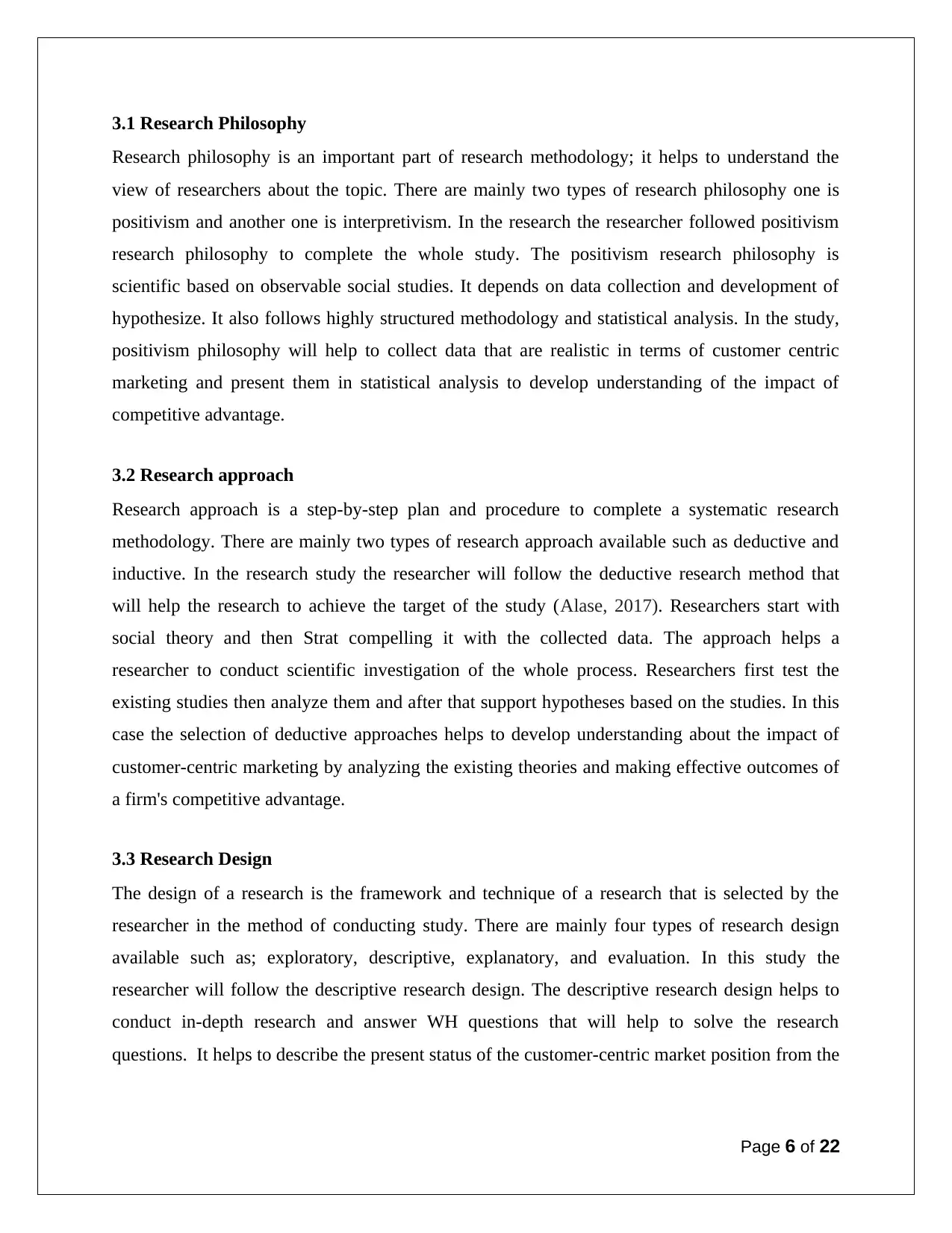
3.1 Research Philosophy
Research philosophy is an important part of research methodology; it helps to understand the
view of researchers about the topic. There are mainly two types of research philosophy one is
positivism and another one is interpretivism. In the research the researcher followed positivism
research philosophy to complete the whole study. The positivism research philosophy is
scientific based on observable social studies. It depends on data collection and development of
hypothesize. It also follows highly structured methodology and statistical analysis. In the study,
positivism philosophy will help to collect data that are realistic in terms of customer centric
marketing and present them in statistical analysis to develop understanding of the impact of
competitive advantage.
3.2 Research approach
Research approach is a step-by-step plan and procedure to complete a systematic research
methodology. There are mainly two types of research approach available such as deductive and
inductive. In the research study the researcher will follow the deductive research method that
will help the research to achieve the target of the study (Alase, 2017). Researchers start with
social theory and then Strat compelling it with the collected data. The approach helps a
researcher to conduct scientific investigation of the whole process. Researchers first test the
existing studies then analyze them and after that support hypotheses based on the studies. In this
case the selection of deductive approaches helps to develop understanding about the impact of
customer-centric marketing by analyzing the existing theories and making effective outcomes of
a firm's competitive advantage.
3.3 Research Design
The design of a research is the framework and technique of a research that is selected by the
researcher in the method of conducting study. There are mainly four types of research design
available such as; exploratory, descriptive, explanatory, and evaluation. In this study the
researcher will follow the descriptive research design. The descriptive research design helps to
conduct in-depth research and answer WH questions that will help to solve the research
questions. It helps to describe the present status of the customer-centric market position from the
Page 6 of 22
Research philosophy is an important part of research methodology; it helps to understand the
view of researchers about the topic. There are mainly two types of research philosophy one is
positivism and another one is interpretivism. In the research the researcher followed positivism
research philosophy to complete the whole study. The positivism research philosophy is
scientific based on observable social studies. It depends on data collection and development of
hypothesize. It also follows highly structured methodology and statistical analysis. In the study,
positivism philosophy will help to collect data that are realistic in terms of customer centric
marketing and present them in statistical analysis to develop understanding of the impact of
competitive advantage.
3.2 Research approach
Research approach is a step-by-step plan and procedure to complete a systematic research
methodology. There are mainly two types of research approach available such as deductive and
inductive. In the research study the researcher will follow the deductive research method that
will help the research to achieve the target of the study (Alase, 2017). Researchers start with
social theory and then Strat compelling it with the collected data. The approach helps a
researcher to conduct scientific investigation of the whole process. Researchers first test the
existing studies then analyze them and after that support hypotheses based on the studies. In this
case the selection of deductive approaches helps to develop understanding about the impact of
customer-centric marketing by analyzing the existing theories and making effective outcomes of
a firm's competitive advantage.
3.3 Research Design
The design of a research is the framework and technique of a research that is selected by the
researcher in the method of conducting study. There are mainly four types of research design
available such as; exploratory, descriptive, explanatory, and evaluation. In this study the
researcher will follow the descriptive research design. The descriptive research design helps to
conduct in-depth research and answer WH questions that will help to solve the research
questions. It helps to describe the present status of the customer-centric market position from the
Page 6 of 22
⊘ This is a preview!⊘
Do you want full access?
Subscribe today to unlock all pages.

Trusted by 1+ million students worldwide
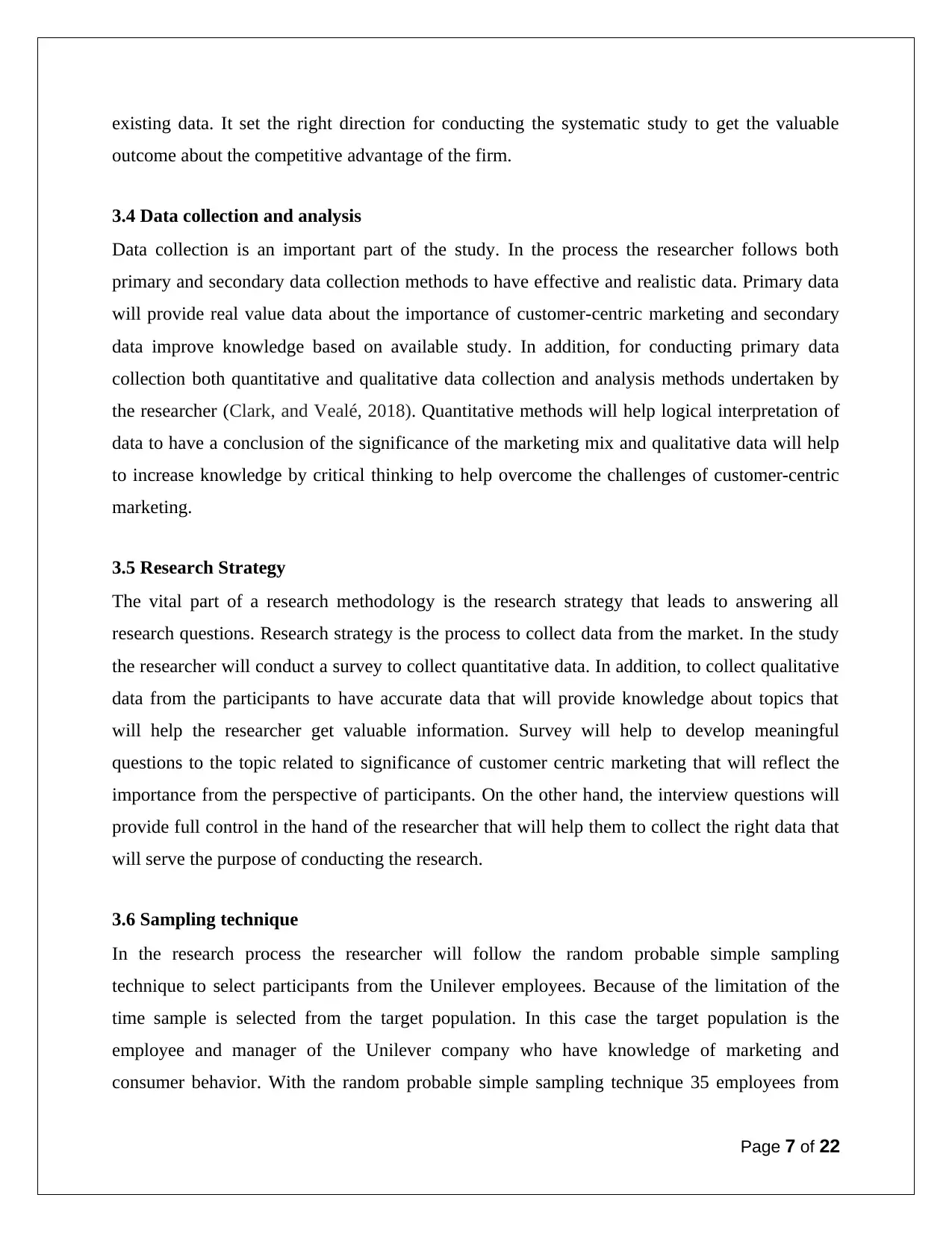
existing data. It set the right direction for conducting the systematic study to get the valuable
outcome about the competitive advantage of the firm.
3.4 Data collection and analysis
Data collection is an important part of the study. In the process the researcher follows both
primary and secondary data collection methods to have effective and realistic data. Primary data
will provide real value data about the importance of customer-centric marketing and secondary
data improve knowledge based on available study. In addition, for conducting primary data
collection both quantitative and qualitative data collection and analysis methods undertaken by
the researcher (Clark, and Vealé, 2018). Quantitative methods will help logical interpretation of
data to have a conclusion of the significance of the marketing mix and qualitative data will help
to increase knowledge by critical thinking to help overcome the challenges of customer-centric
marketing.
3.5 Research Strategy
The vital part of a research methodology is the research strategy that leads to answering all
research questions. Research strategy is the process to collect data from the market. In the study
the researcher will conduct a survey to collect quantitative data. In addition, to collect qualitative
data from the participants to have accurate data that will provide knowledge about topics that
will help the researcher get valuable information. Survey will help to develop meaningful
questions to the topic related to significance of customer centric marketing that will reflect the
importance from the perspective of participants. On the other hand, the interview questions will
provide full control in the hand of the researcher that will help them to collect the right data that
will serve the purpose of conducting the research.
3.6 Sampling technique
In the research process the researcher will follow the random probable simple sampling
technique to select participants from the Unilever employees. Because of the limitation of the
time sample is selected from the target population. In this case the target population is the
employee and manager of the Unilever company who have knowledge of marketing and
consumer behavior. With the random probable simple sampling technique 35 employees from
Page 7 of 22
outcome about the competitive advantage of the firm.
3.4 Data collection and analysis
Data collection is an important part of the study. In the process the researcher follows both
primary and secondary data collection methods to have effective and realistic data. Primary data
will provide real value data about the importance of customer-centric marketing and secondary
data improve knowledge based on available study. In addition, for conducting primary data
collection both quantitative and qualitative data collection and analysis methods undertaken by
the researcher (Clark, and Vealé, 2018). Quantitative methods will help logical interpretation of
data to have a conclusion of the significance of the marketing mix and qualitative data will help
to increase knowledge by critical thinking to help overcome the challenges of customer-centric
marketing.
3.5 Research Strategy
The vital part of a research methodology is the research strategy that leads to answering all
research questions. Research strategy is the process to collect data from the market. In the study
the researcher will conduct a survey to collect quantitative data. In addition, to collect qualitative
data from the participants to have accurate data that will provide knowledge about topics that
will help the researcher get valuable information. Survey will help to develop meaningful
questions to the topic related to significance of customer centric marketing that will reflect the
importance from the perspective of participants. On the other hand, the interview questions will
provide full control in the hand of the researcher that will help them to collect the right data that
will serve the purpose of conducting the research.
3.6 Sampling technique
In the research process the researcher will follow the random probable simple sampling
technique to select participants from the Unilever employees. Because of the limitation of the
time sample is selected from the target population. In this case the target population is the
employee and manager of the Unilever company who have knowledge of marketing and
consumer behavior. With the random probable simple sampling technique 35 employees from
Page 7 of 22
Paraphrase This Document
Need a fresh take? Get an instant paraphrase of this document with our AI Paraphraser
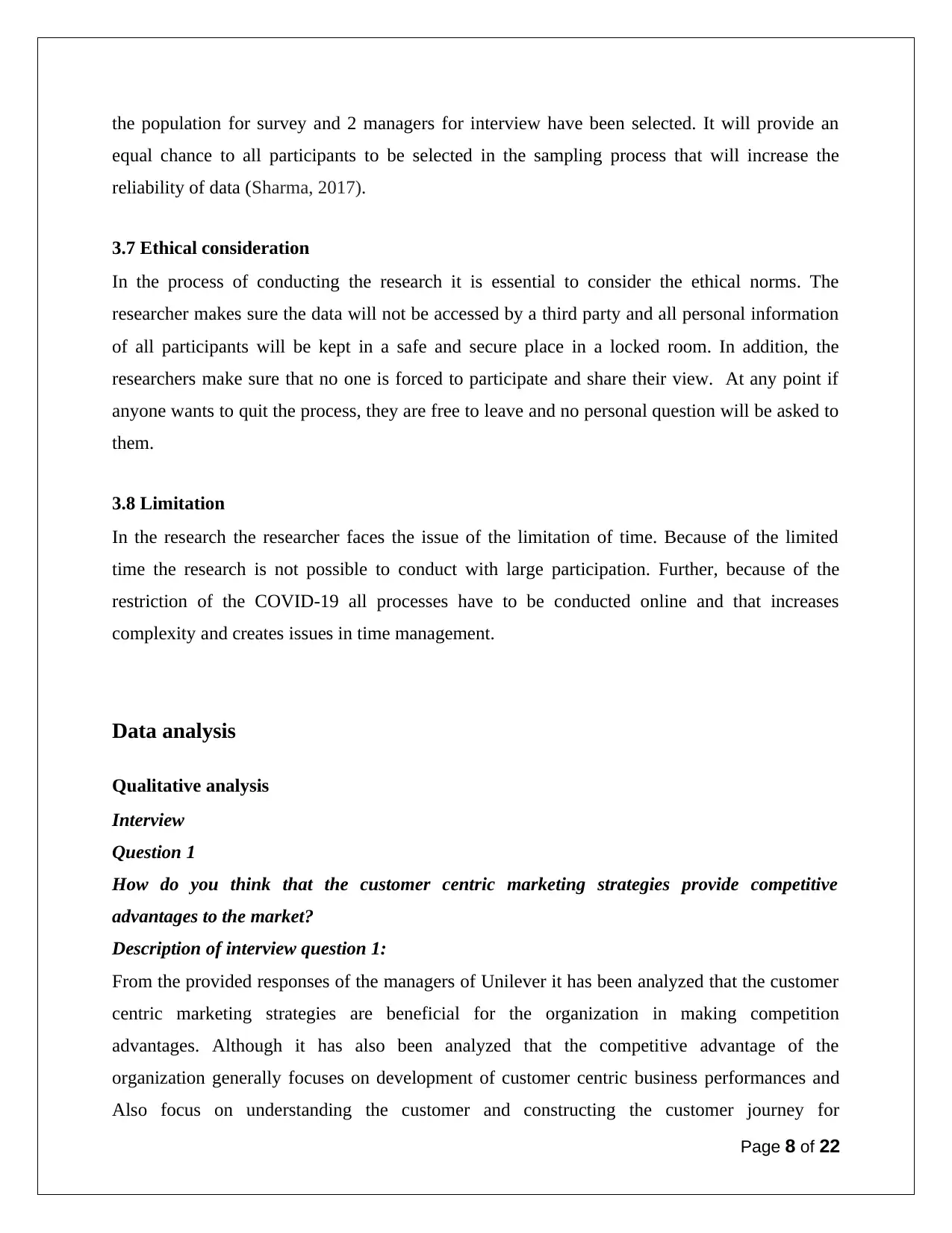
the population for survey and 2 managers for interview have been selected. It will provide an
equal chance to all participants to be selected in the sampling process that will increase the
reliability of data (Sharma, 2017).
3.7 Ethical consideration
In the process of conducting the research it is essential to consider the ethical norms. The
researcher makes sure the data will not be accessed by a third party and all personal information
of all participants will be kept in a safe and secure place in a locked room. In addition, the
researchers make sure that no one is forced to participate and share their view. At any point if
anyone wants to quit the process, they are free to leave and no personal question will be asked to
them.
3.8 Limitation
In the research the researcher faces the issue of the limitation of time. Because of the limited
time the research is not possible to conduct with large participation. Further, because of the
restriction of the COVID-19 all processes have to be conducted online and that increases
complexity and creates issues in time management.
Data analysis
Qualitative analysis
Interview
Question 1
How do you think that the customer centric marketing strategies provide competitive
advantages to the market?
Description of interview question 1:
From the provided responses of the managers of Unilever it has been analyzed that the customer
centric marketing strategies are beneficial for the organization in making competition
advantages. Although it has also been analyzed that the competitive advantage of the
organization generally focuses on development of customer centric business performances and
Also focus on understanding the customer and constructing the customer journey for
Page 8 of 22
equal chance to all participants to be selected in the sampling process that will increase the
reliability of data (Sharma, 2017).
3.7 Ethical consideration
In the process of conducting the research it is essential to consider the ethical norms. The
researcher makes sure the data will not be accessed by a third party and all personal information
of all participants will be kept in a safe and secure place in a locked room. In addition, the
researchers make sure that no one is forced to participate and share their view. At any point if
anyone wants to quit the process, they are free to leave and no personal question will be asked to
them.
3.8 Limitation
In the research the researcher faces the issue of the limitation of time. Because of the limited
time the research is not possible to conduct with large participation. Further, because of the
restriction of the COVID-19 all processes have to be conducted online and that increases
complexity and creates issues in time management.
Data analysis
Qualitative analysis
Interview
Question 1
How do you think that the customer centric marketing strategies provide competitive
advantages to the market?
Description of interview question 1:
From the provided responses of the managers of Unilever it has been analyzed that the customer
centric marketing strategies are beneficial for the organization in making competition
advantages. Although it has also been analyzed that the competitive advantage of the
organization generally focuses on development of customer centric business performances and
Also focus on understanding the customer and constructing the customer journey for
Page 8 of 22
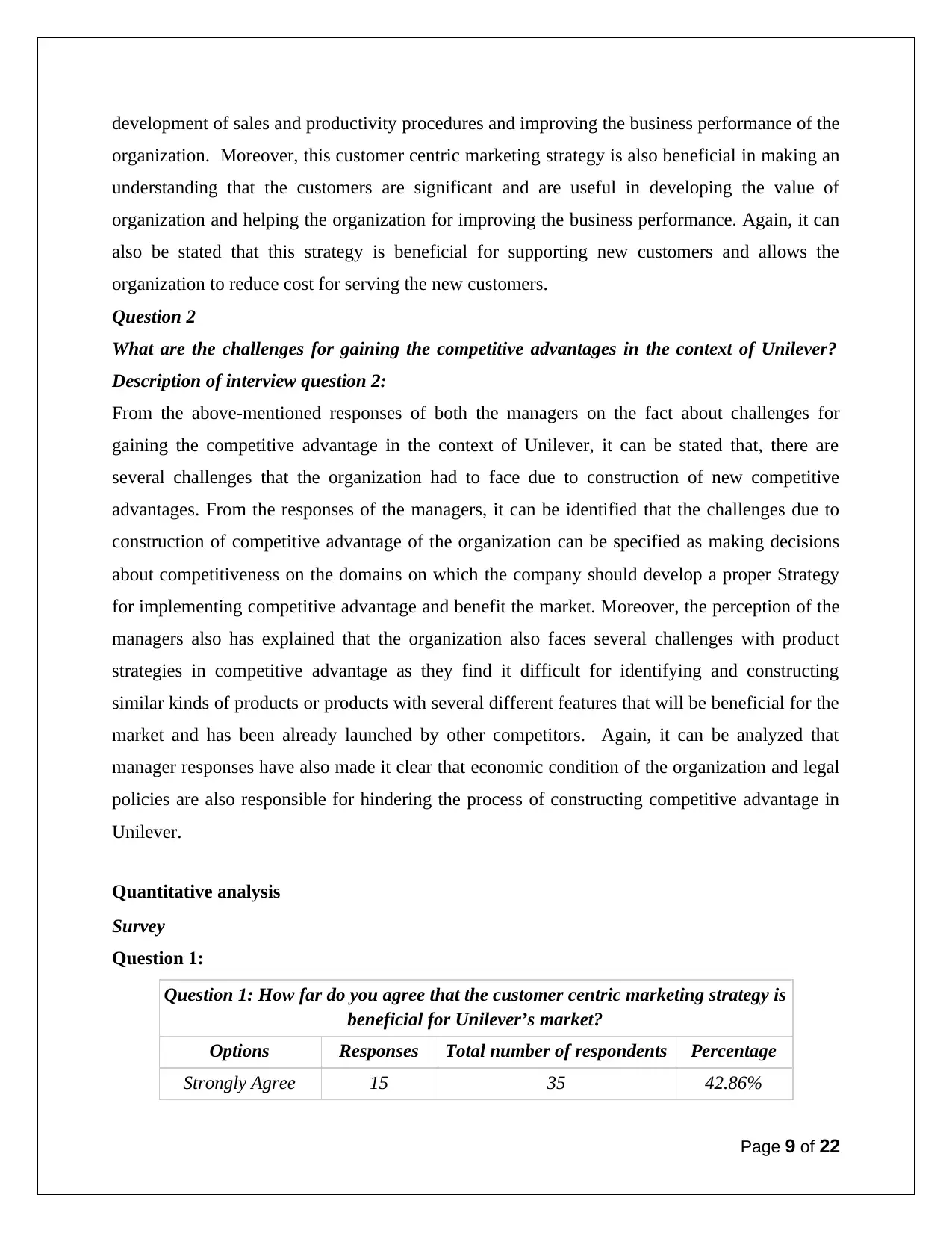
development of sales and productivity procedures and improving the business performance of the
organization. Moreover, this customer centric marketing strategy is also beneficial in making an
understanding that the customers are significant and are useful in developing the value of
organization and helping the organization for improving the business performance. Again, it can
also be stated that this strategy is beneficial for supporting new customers and allows the
organization to reduce cost for serving the new customers.
Question 2
What are the challenges for gaining the competitive advantages in the context of Unilever?
Description of interview question 2:
From the above-mentioned responses of both the managers on the fact about challenges for
gaining the competitive advantage in the context of Unilever, it can be stated that, there are
several challenges that the organization had to face due to construction of new competitive
advantages. From the responses of the managers, it can be identified that the challenges due to
construction of competitive advantage of the organization can be specified as making decisions
about competitiveness on the domains on which the company should develop a proper Strategy
for implementing competitive advantage and benefit the market. Moreover, the perception of the
managers also has explained that the organization also faces several challenges with product
strategies in competitive advantage as they find it difficult for identifying and constructing
similar kinds of products or products with several different features that will be beneficial for the
market and has been already launched by other competitors. Again, it can be analyzed that
manager responses have also made it clear that economic condition of the organization and legal
policies are also responsible for hindering the process of constructing competitive advantage in
Unilever.
Quantitative analysis
Survey
Question 1:
Question 1: How far do you agree that the customer centric marketing strategy is
beneficial for Unilever’s market?
Options Responses Total number of respondents Percentage
Strongly Agree 15 35 42.86%
Page 9 of 22
organization. Moreover, this customer centric marketing strategy is also beneficial in making an
understanding that the customers are significant and are useful in developing the value of
organization and helping the organization for improving the business performance. Again, it can
also be stated that this strategy is beneficial for supporting new customers and allows the
organization to reduce cost for serving the new customers.
Question 2
What are the challenges for gaining the competitive advantages in the context of Unilever?
Description of interview question 2:
From the above-mentioned responses of both the managers on the fact about challenges for
gaining the competitive advantage in the context of Unilever, it can be stated that, there are
several challenges that the organization had to face due to construction of new competitive
advantages. From the responses of the managers, it can be identified that the challenges due to
construction of competitive advantage of the organization can be specified as making decisions
about competitiveness on the domains on which the company should develop a proper Strategy
for implementing competitive advantage and benefit the market. Moreover, the perception of the
managers also has explained that the organization also faces several challenges with product
strategies in competitive advantage as they find it difficult for identifying and constructing
similar kinds of products or products with several different features that will be beneficial for the
market and has been already launched by other competitors. Again, it can be analyzed that
manager responses have also made it clear that economic condition of the organization and legal
policies are also responsible for hindering the process of constructing competitive advantage in
Unilever.
Quantitative analysis
Survey
Question 1:
Question 1: How far do you agree that the customer centric marketing strategy is
beneficial for Unilever’s market?
Options Responses Total number of respondents Percentage
Strongly Agree 15 35 42.86%
Page 9 of 22
⊘ This is a preview!⊘
Do you want full access?
Subscribe today to unlock all pages.

Trusted by 1+ million students worldwide
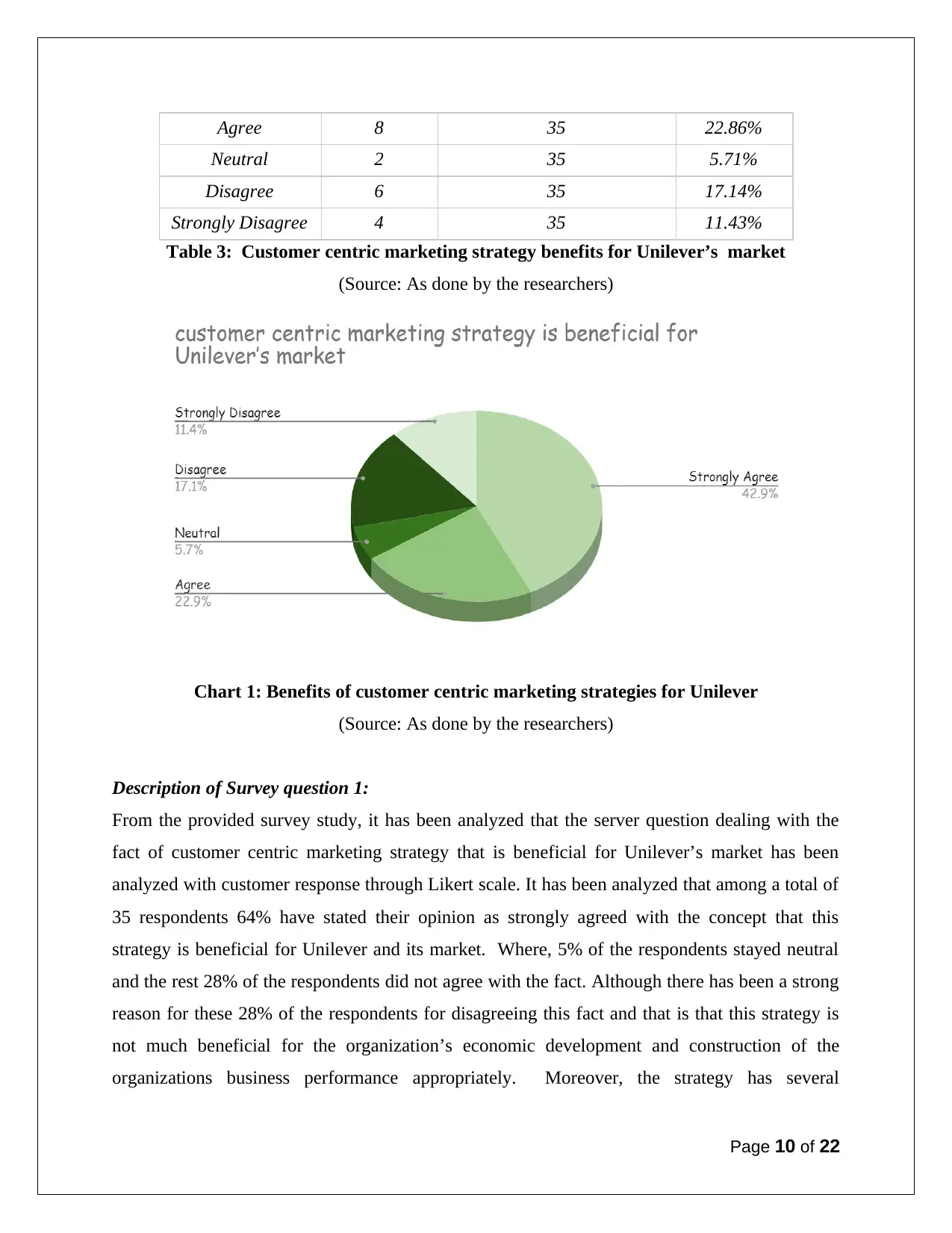
Agree 8 35 22.86%
Neutral 2 35 5.71%
Disagree 6 35 17.14%
Strongly Disagree 4 35 11.43%
Table 3: Customer centric marketing strategy benefits for Unilever’s market
(Source: As done by the researchers)
Chart 1: Benefits of customer centric marketing strategies for Unilever
(Source: As done by the researchers)
Description of Survey question 1:
From the provided survey study, it has been analyzed that the server question dealing with the
fact of customer centric marketing strategy that is beneficial for Unilever’s market has been
analyzed with customer response through Likert scale. It has been analyzed that among a total of
35 respondents 64% have stated their opinion as strongly agreed with the concept that this
strategy is beneficial for Unilever and its market. Where, 5% of the respondents stayed neutral
and the rest 28% of the respondents did not agree with the fact. Although there has been a strong
reason for these 28% of the respondents for disagreeing this fact and that is that this strategy is
not much beneficial for the organization’s economic development and construction of the
organizations business performance appropriately. Moreover, the strategy has several
Page 10 of 22
Neutral 2 35 5.71%
Disagree 6 35 17.14%
Strongly Disagree 4 35 11.43%
Table 3: Customer centric marketing strategy benefits for Unilever’s market
(Source: As done by the researchers)
Chart 1: Benefits of customer centric marketing strategies for Unilever
(Source: As done by the researchers)
Description of Survey question 1:
From the provided survey study, it has been analyzed that the server question dealing with the
fact of customer centric marketing strategy that is beneficial for Unilever’s market has been
analyzed with customer response through Likert scale. It has been analyzed that among a total of
35 respondents 64% have stated their opinion as strongly agreed with the concept that this
strategy is beneficial for Unilever and its market. Where, 5% of the respondents stayed neutral
and the rest 28% of the respondents did not agree with the fact. Although there has been a strong
reason for these 28% of the respondents for disagreeing this fact and that is that this strategy is
not much beneficial for the organization’s economic development and construction of the
organizations business performance appropriately. Moreover, the strategy has several
Page 10 of 22
Paraphrase This Document
Need a fresh take? Get an instant paraphrase of this document with our AI Paraphraser
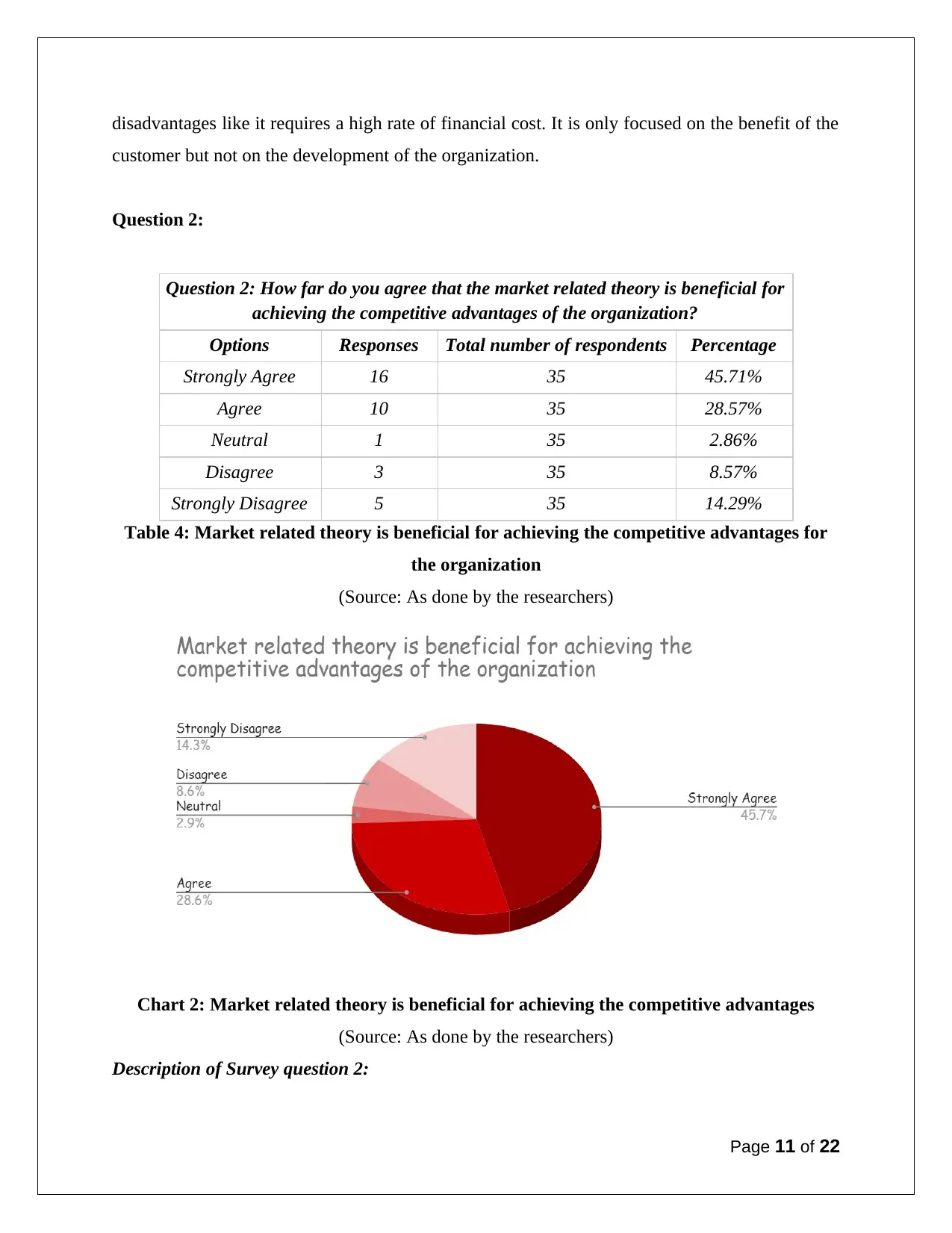
disadvantages like it requires a high rate of financial cost. It is only focused on the benefit of the
customer but not on the development of the organization.
Question 2:
Question 2: How far do you agree that the market related theory is beneficial for
achieving the competitive advantages of the organization?
Options Responses Total number of respondents Percentage
Strongly Agree 16 35 45.71%
Agree 10 35 28.57%
Neutral 1 35 2.86%
Disagree 3 35 8.57%
Strongly Disagree 5 35 14.29%
Table 4: Market related theory is beneficial for achieving the competitive advantages for
the organization
(Source: As done by the researchers)
Chart 2: Market related theory is beneficial for achieving the competitive advantages
(Source: As done by the researchers)
Description of Survey question 2:
Page 11 of 22
customer but not on the development of the organization.
Question 2:
Question 2: How far do you agree that the market related theory is beneficial for
achieving the competitive advantages of the organization?
Options Responses Total number of respondents Percentage
Strongly Agree 16 35 45.71%
Agree 10 35 28.57%
Neutral 1 35 2.86%
Disagree 3 35 8.57%
Strongly Disagree 5 35 14.29%
Table 4: Market related theory is beneficial for achieving the competitive advantages for
the organization
(Source: As done by the researchers)
Chart 2: Market related theory is beneficial for achieving the competitive advantages
(Source: As done by the researchers)
Description of Survey question 2:
Page 11 of 22
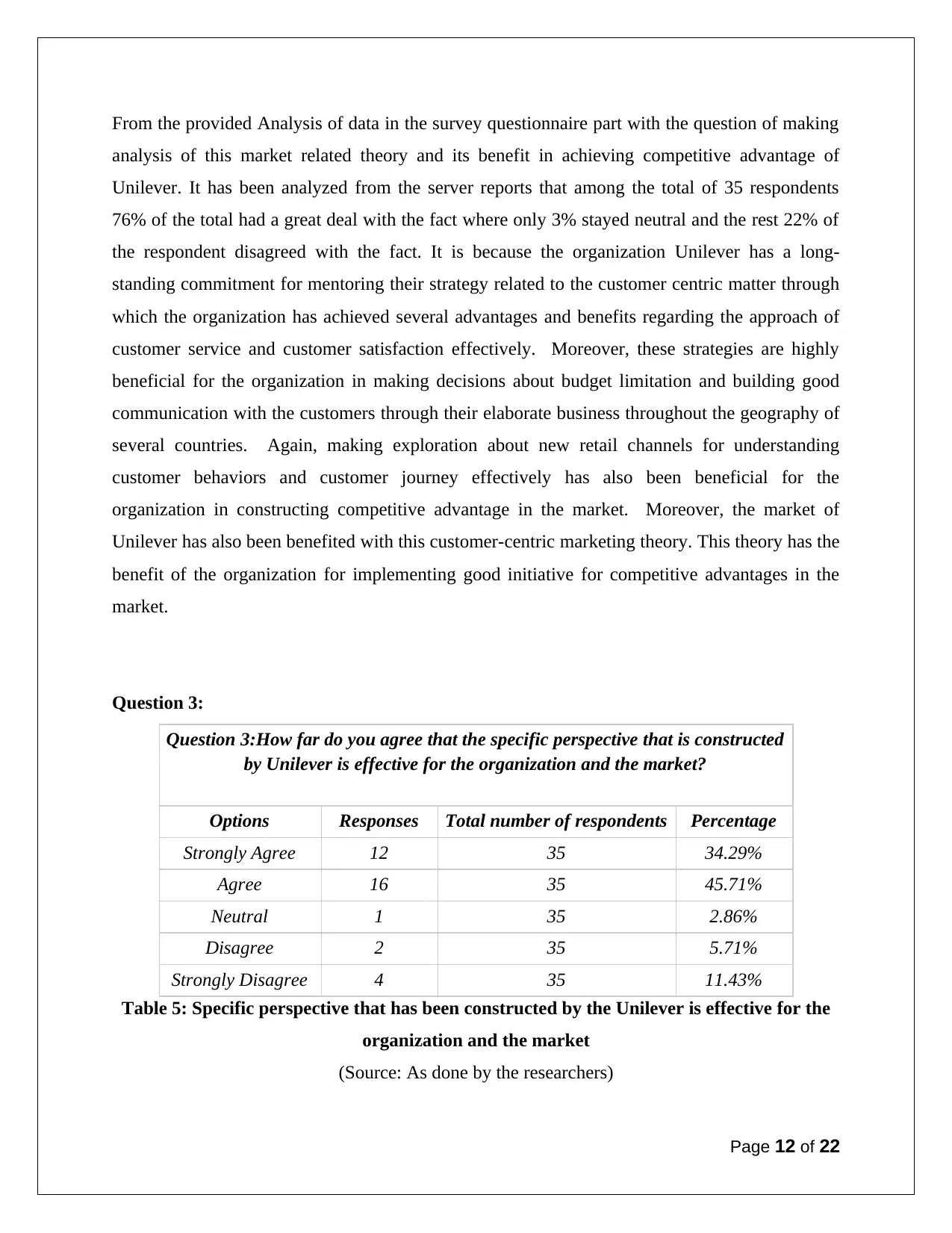
From the provided Analysis of data in the survey questionnaire part with the question of making
analysis of this market related theory and its benefit in achieving competitive advantage of
Unilever. It has been analyzed from the server reports that among the total of 35 respondents
76% of the total had a great deal with the fact where only 3% stayed neutral and the rest 22% of
the respondent disagreed with the fact. It is because the organization Unilever has a long-
standing commitment for mentoring their strategy related to the customer centric matter through
which the organization has achieved several advantages and benefits regarding the approach of
customer service and customer satisfaction effectively. Moreover, these strategies are highly
beneficial for the organization in making decisions about budget limitation and building good
communication with the customers through their elaborate business throughout the geography of
several countries. Again, making exploration about new retail channels for understanding
customer behaviors and customer journey effectively has also been beneficial for the
organization in constructing competitive advantage in the market. Moreover, the market of
Unilever has also been benefited with this customer-centric marketing theory. This theory has the
benefit of the organization for implementing good initiative for competitive advantages in the
market.
Question 3:
Question 3:How far do you agree that the specific perspective that is constructed
by Unilever is effective for the organization and the market?
Options Responses Total number of respondents Percentage
Strongly Agree 12 35 34.29%
Agree 16 35 45.71%
Neutral 1 35 2.86%
Disagree 2 35 5.71%
Strongly Disagree 4 35 11.43%
Table 5: Specific perspective that has been constructed by the Unilever is effective for the
organization and the market
(Source: As done by the researchers)
Page 12 of 22
analysis of this market related theory and its benefit in achieving competitive advantage of
Unilever. It has been analyzed from the server reports that among the total of 35 respondents
76% of the total had a great deal with the fact where only 3% stayed neutral and the rest 22% of
the respondent disagreed with the fact. It is because the organization Unilever has a long-
standing commitment for mentoring their strategy related to the customer centric matter through
which the organization has achieved several advantages and benefits regarding the approach of
customer service and customer satisfaction effectively. Moreover, these strategies are highly
beneficial for the organization in making decisions about budget limitation and building good
communication with the customers through their elaborate business throughout the geography of
several countries. Again, making exploration about new retail channels for understanding
customer behaviors and customer journey effectively has also been beneficial for the
organization in constructing competitive advantage in the market. Moreover, the market of
Unilever has also been benefited with this customer-centric marketing theory. This theory has the
benefit of the organization for implementing good initiative for competitive advantages in the
market.
Question 3:
Question 3:How far do you agree that the specific perspective that is constructed
by Unilever is effective for the organization and the market?
Options Responses Total number of respondents Percentage
Strongly Agree 12 35 34.29%
Agree 16 35 45.71%
Neutral 1 35 2.86%
Disagree 2 35 5.71%
Strongly Disagree 4 35 11.43%
Table 5: Specific perspective that has been constructed by the Unilever is effective for the
organization and the market
(Source: As done by the researchers)
Page 12 of 22
⊘ This is a preview!⊘
Do you want full access?
Subscribe today to unlock all pages.

Trusted by 1+ million students worldwide
1 out of 22
Related Documents
Your All-in-One AI-Powered Toolkit for Academic Success.
+13062052269
info@desklib.com
Available 24*7 on WhatsApp / Email
![[object Object]](/_next/static/media/star-bottom.7253800d.svg)
Unlock your academic potential
Copyright © 2020–2025 A2Z Services. All Rights Reserved. Developed and managed by ZUCOL.




